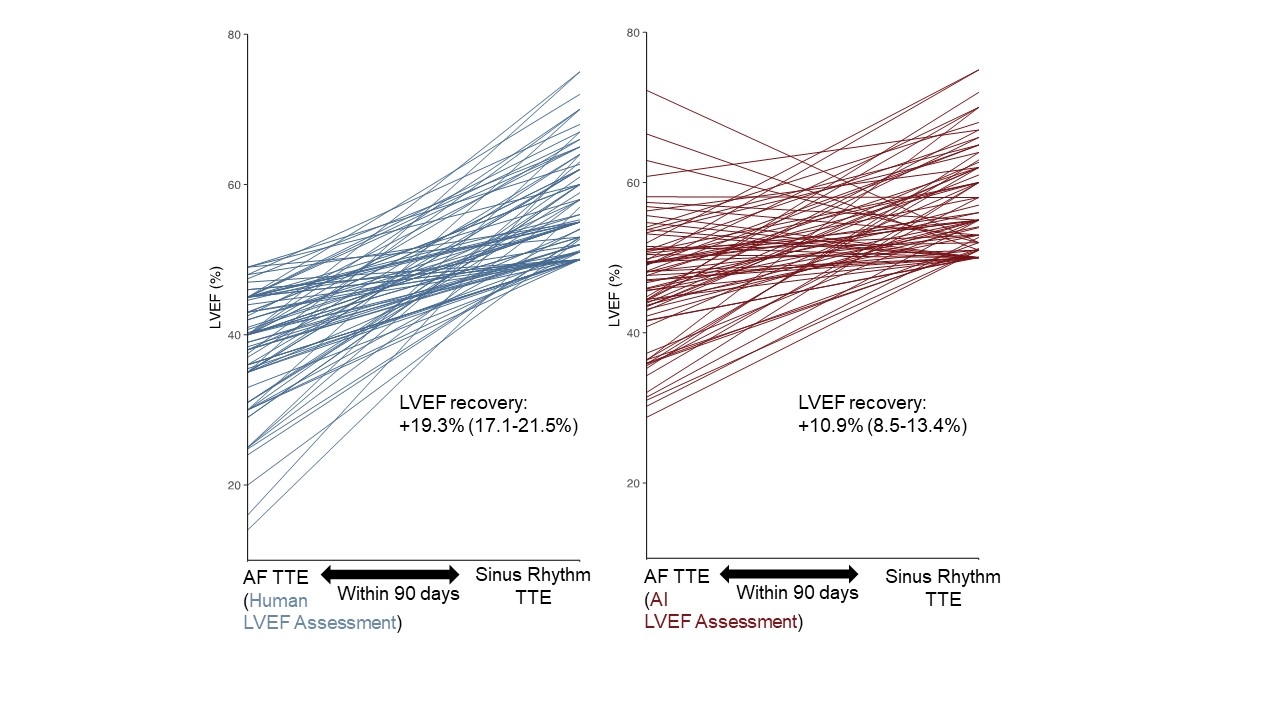Final ID: MDP972
Artificial Intelligence-Enhanced Echocardiogram Assessment Helps Distinguish Cardiomyopathy from Beat-to-Beat Variation in Atrial Fibrillation
Abstract Body (Do not enter title and authors here): Background
Atrial fibrillation (AF) can be associated with reductions in left ventricular ejection fraction (LVEF) that improve upon conversion of AF to sinus rhythm. Such LVEF changes during AF may be due to LVEF measurement error from beat-to-beat variations related to AF itself. More precise artificial intelligence (AI)-enhanced LVEF assessment could help distinguish between such LVEF “pseudo-reduction” during AF and true cardiomyopathy, thus potentially preventing unnecessary downstream workup and treatment.
Methods
Using a transthoracic echocardiogram database at a large academic medical center, we identified all patients whose LVEF fell below 50% while in AF who had subsequent LVEF recovery to over 50% within 90 days after converting from AF to sinus rhythm. For echocardiograms in AF, we compared the clinically assessed LVEF with AI-enhanced LVEF assessment by EchoNet-Dynamic, a validated deep learning algorithm.
Results
In our cohort of 84 patients, the mean age was 74 years old, 36.9% were female, and 26.2% non-White. The mean LVEF recovery was 19.3% (95% CI 17.1-21.5%) after converting from AF to sinus rhythm with a mean duration of 27.4 days between the AF and sinus rhythm echocardiograms (Figure 1). For AF echocardiograms, the LVEF when reassessed by deep learning was 8.4% (6.3-10.5%) higher than the original clinical read, resulting in 30.3% of patients being reclassified as no longer having a reduced LVEF less than 50% while in AF. Among these patients with LVEF reductions during AF, 27.4% and 19.0% were given a new or worsened heart failure with reduced ejection fraction (HFrEF) diagnosis, 15.5% underwent ischemic testing, and 17.9% were started on new HFrEF medications.
Discussion
LVEF reductions during AF can lead to new HFrEF diagnosis, workup, and treatment. However, such LVEF reductions may be temporary and partially explained by undermeasurement of LVEF during AF. AI-enhanced LVEF assessment may help reduce such measurement errors during AF and thereby prevent overdiagnosis of HFrEF. Further research is needed to understand the clinical significance of true but temporary LVEF reductions during AF.
Atrial fibrillation (AF) can be associated with reductions in left ventricular ejection fraction (LVEF) that improve upon conversion of AF to sinus rhythm. Such LVEF changes during AF may be due to LVEF measurement error from beat-to-beat variations related to AF itself. More precise artificial intelligence (AI)-enhanced LVEF assessment could help distinguish between such LVEF “pseudo-reduction” during AF and true cardiomyopathy, thus potentially preventing unnecessary downstream workup and treatment.
Methods
Using a transthoracic echocardiogram database at a large academic medical center, we identified all patients whose LVEF fell below 50% while in AF who had subsequent LVEF recovery to over 50% within 90 days after converting from AF to sinus rhythm. For echocardiograms in AF, we compared the clinically assessed LVEF with AI-enhanced LVEF assessment by EchoNet-Dynamic, a validated deep learning algorithm.
Results
In our cohort of 84 patients, the mean age was 74 years old, 36.9% were female, and 26.2% non-White. The mean LVEF recovery was 19.3% (95% CI 17.1-21.5%) after converting from AF to sinus rhythm with a mean duration of 27.4 days between the AF and sinus rhythm echocardiograms (Figure 1). For AF echocardiograms, the LVEF when reassessed by deep learning was 8.4% (6.3-10.5%) higher than the original clinical read, resulting in 30.3% of patients being reclassified as no longer having a reduced LVEF less than 50% while in AF. Among these patients with LVEF reductions during AF, 27.4% and 19.0% were given a new or worsened heart failure with reduced ejection fraction (HFrEF) diagnosis, 15.5% underwent ischemic testing, and 17.9% were started on new HFrEF medications.
Discussion
LVEF reductions during AF can lead to new HFrEF diagnosis, workup, and treatment. However, such LVEF reductions may be temporary and partially explained by undermeasurement of LVEF during AF. AI-enhanced LVEF assessment may help reduce such measurement errors during AF and thereby prevent overdiagnosis of HFrEF. Further research is needed to understand the clinical significance of true but temporary LVEF reductions during AF.
More abstracts on this topic:
Cardiomyocyte TRPV4 Deletion Mitigates Adverse Cardiac Remodeling Via Modulation of Protein Kinase G signaling
Katari Venkatesh, Dalal Kesha, Kondapalli Narendra, Paruchuri Sailaja, Thodeti Charles
A novel deep learning framework identified associated genes and Interpretable deep learning translation of GWAS findings for drug repurposing in Atrial FibrillationTonegawa-kuji Reina, Xu Jielin, Guntupalli Suman, Barnard John, Chung Mina, Cheng Feixiong

